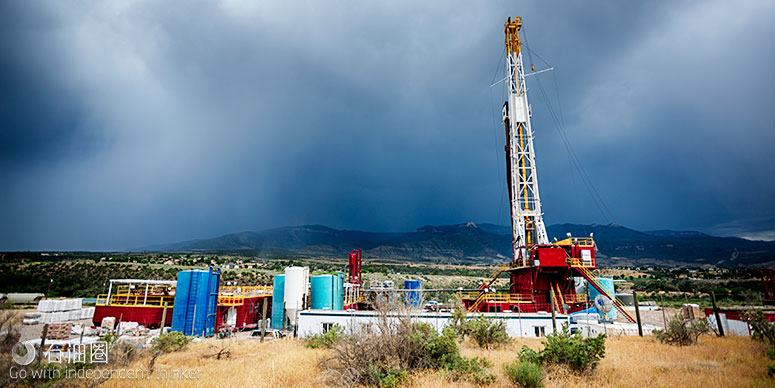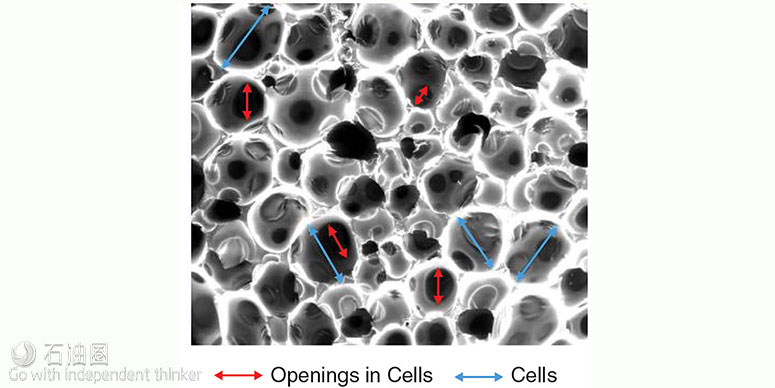Conventional openhole sand-control techniques include standalone screens, expandable screens, and openhole gravel packing (OHGP). In some cases, the uniformity, size, and level of compressive strength of the formation dictate the use of an OHGP completion. However, OHGP is not always feasible or practical for some reservoirs and geographic locations. Shape-memory-polymer (SMP) technology can fill the gaps that exist with current OHGP techniques. This paper summarizes a technology using SMP to provide downhole sand control in openhole environments.
Introduction
The SMP conformable sand-control system consists of an engineered polymer material compacted onto a retainer cartridge (outer shroud, plain Dutch-weave mesh, and inner shroud). The assembly is then installed onto a perforated base pipe by mechanical means to provide a simple modular system for openhole sand-control applications.
SMP Principle and Engineered Behaviors. The SMP typically has two different states: the glass state at low temperatures and the rubber state at higher temperatures. The point of change of state (the transition from the glass state to the rubber state), and the associated temperature, is referred to as the glass transit temperature (Tg).
The engineered SMP has a defined Tg—the point where shape recovery starts. The initial SMP is first heated to the Tg of the polymer. Then, a mechanical force is applied to compact it to a smaller diameter and onto a retainer cartridge. The condensed SMP is then cooled below its Tg, and the force is removed. The SMP retains its compacted size until the surrounding temperature of the SMP reaches the Tg, at which point shape recovery begins.
The bottomhole temperature (BHT) of the candidate reservoirs needs to be lower than the Tg to ensure that the SMP is rigid under the downhole conditions during the production phase. After the SMP sand-control system is installed in a wellbore, to expand the SMP under a BHT that is lower than the Tg, an activation fluid must be introduced. This activation fluid serves as a catalyst and temporarily reduces the Tg below the BHT so the SMP will be recovered to its initial shape. After the SMP is deployed, the activation fluid is flushed out. The SMP retains its recovered shape that conforms to the wellbore, and it is ready for production.
SMP Sand-Retention and Filtration Capabilities
To evaluate the SMP sand-retention and filtration capabilities, besides the standard prepack tests and slurry tests, additional tests were conducted to simulate the effect of reservoir compaction on the performance of the SMP. These tests applied a dynamic load through the simulated formation sand and the sand-control media.
Dynamic Filtration Tests and Results. Many formation sands with different particle-size distributions (PSDs) have been tested by measuring the pressure drop across a layer of sand and the SMP specimen as well as measuring the amount of effluent that passed through the tested media. Test results show that the total particles in the effluent of each test are less than 10% of the total sand used in the test. More than 90% of the produced-sand particles are less than 44 μm, regardless of the uniformity coefficient, the sorting coefficient, and the fines percentage.
These sands are very different in terms of sand-particle sizes, sorting, uniformity, and fines percentage. However, with the same size/type of SMP, the sand–filtration performances from these tests are satisfactory, with no indication of plugging or undesirable sand production.
Performance Comparisons Between the SMP and OHGP
The SMP is made up of irregularly shaped cells with multiple openings (slits) for cell-to-cell connectivity and flow path (Fig. 1). This unique structure enables the SMP to achieve sand control by allowing particles less than 44 μm in size to pass through, regardless of the formation PSD. It is a one-size-fits-all sand–control medium. To examine the sand-retention capability of the SMP and OHGP systems and compare them, three simulated formation sands with low, medium, and high uniformity coefficients, respectively, were tested. Results indicated that, for a given formation sand, it is necessary to size the OHGP gravel/screen on the basis of the formation PSD to effectively control the sand.
The test results indicate a lower sand production for a smaller-sized gravel system (40/60-US-mesh gravels) but higher pressure drop across the tested media and, conversely, higher sand production for larger gravel sizes (12/20-mesh gravels) with lower pressure drop. These analyses also show some variation in performances between wire-wrap screens and mesh screens when the same gravel sizes were used.
The SMP, in comparison, has a pressure-drop profile similar to the 20/40-US-mesh gravel-pack test, but it maintains a better sand-control efficiency by producing less formation sand and keeping the particle size of the produced sands to less than 44 μm.
SMP-Application BHT Range and Activation-Fluid Design
Deployment of the SMP is primarily dependent on the variation of the surrounding temperature with respect to the inherent Tg of the SMP material. Activation of the SMP expansion occurs if the surrounding temperature is higher than the Tg of the SMP; otherwise, no activation occurs. The transition of the SMP varies on the basis of its surrounding fluid. It requires higher temperature to commence activation in a dry environment (such as in air) than in a wet environment (such as in a liquid).
Before wellbore installation of the SMP, the candidate well should have a BHT that is below the Tg to ensure that the SMP remains rigid and will not change shape. Consequently, to activate the SMP in bottomhole conditions, the bottomhole fluid would have to be an activation fluid. The activation fluid comprises the wellbore completion fluid with an addition of a smaller fraction of solvent, called an activator in this paper. The activator in the activation fluid acts as a catalyst. It temporarily reduces the Tg of the SMP to a level below the BHT, enabling the BHT to activate the SMP expansion at reservoir conditions. As a result, a wellbore-completion design using a SMP conformable sand-control system requires a review of the candidate-reservoir BHT and design of an activation fluid to deploy the SMP after installation.
The suitable BHT to use the SMP conformable sand-control system is between 100 and 200°F. Recent research-and–development studies also indicated that SMP field application in reservoirs with temperatures as low as 40°F is also possible. Deployment in such low-temperature reservoirs requires the use of a nonconventional activator.
Activation-Fluid Design
The reservoir with a higher BHT requires a lower concentration of activator in the activation fluid to achieve SMP expansion to the reservoir gauge hole and beyond. Conversely, the lower the BHT of the reservoir, the higher the concentration of activator needed in the activation fluid to bring about the SMP expansion.
An activation fluid comprises the base completion fluid and the SMP activator. The concentration of the activator depends on the reservoir BHT and the type of base fluid (such as completion brine, conditioned mud, or filter-cake-breaker fluid).
Typically, the activator concentration is less than 9% by volume of the activation fluid, to ensure that the flash point of the activation fluid is kept in a low-risk category during field operation. An analysis of the SMP-expansion rate was performed with varying activator concentrations and water-based mud and potassium chloride brine as base fluids. Each test was carried out at 195°F to ensure that the observable differences in activation duration were caused only by the different fluid environments.
The results of these studies verify that, in conjunction with the temperature of the test environment, the type of fluid also affects the expansion rate.
Activation-Fluid Design With Filter-Cake-Breaker Fluid
Breaker fluids are typically pumped downhole to cover the entire openhole region and break down the mud filter cake. These fluids consist of surfactants and other solvents that disperse filter cakes and remove other organic depositions such as asphaltene that can ultimately reduce effective permeability. Stated simply, breaker fluids are used to improve productivity. To save rig time and to avoid multiple trips, it is advantageous to combine the breaker fluid with the activator needed for SMP deployment. In fact, studies have shown that some breaker fluids are composed of organic compounds that are similar to the SMP activator, in which case the breaker fluid can, on its own, deploy the SMP.
Openhole Preparation and Operational Procedures
Similar to conventional sand-control-screen deployment, wellbore cleanliness is very important for SMP applications. To ensure successful application, it is highly recommended to implement industry best practices (discussed in the complete paper) in openhole preparation before installation.
Operational Procedure. The SMP conformable sand-control system can be deployed using conventional installation techniques for standalone screens coupled with the following criteria:
1.The completion bottomhole assembly (BHA) must be configured to enable a full-bore flow path to the shoe. This is critical so that the activation fluid can be pumped in a manner that enables displacement to start from the shoe (at the bottom of the assembly) to the surface.
2.The completion-tool BHA must be equipped with features that prevent accidental liftoff (swab) of the filter cake. During tubing movement in and out of the packer sealbore, the system must have a uniform hydrostatic communication at all times. This is also a critical requirement because accidental liftoff of the mud filter cake can result in loss of the activation fluid. Techniques for installation can be deployed by a liner-hanger configuration or by a sand-control-packer configuration. These procedures are outlined in the complete paper.

 石油圈
石油圈

